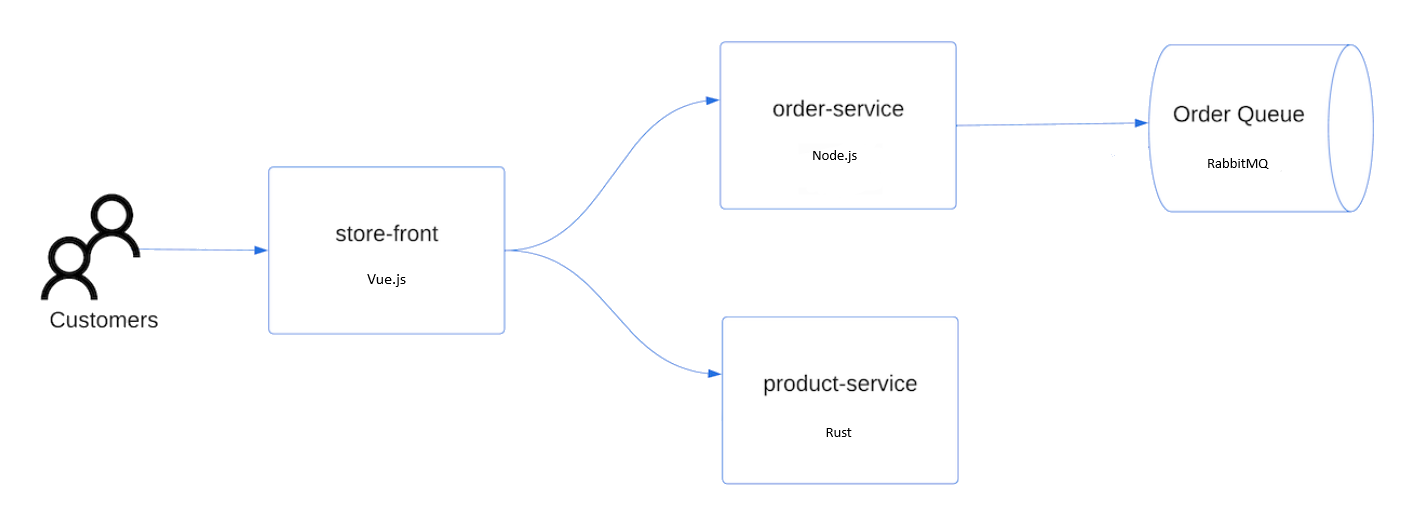Azure Kubernetes Service (AKS) 是受控 Kubernetes 服務,可讓您快速部署及管理叢集。 在此快速入門中,您可了解如何:
- 使用 Azure CLI 部署 AKS 叢集。
- 使用一組微服務和 Web 前端來執行範例多容器應用程式,以模擬零售案例。
Note
本文包含僅針對評估目的使用預設設定部署叢集的步驟。 部署生產環境就緒的叢集之前,建議您先熟悉基準 參考架構 ,以考慮其如何符合您的業務需求。
開始之前
本快速入門假設您已有 Kubernetes 概念的基本知識。 如需詳細資訊,請參閱 Azure Kubernetes Services (AKS) 的 Kubernetes 核心概念。
- 如果您沒有 Azure 帳戶,請在開始之前建立 免費帳戶 。
在 Azure Cloud Shell 中使用 Bash 環境。 如需詳細資訊,請參閱開始使用 Azure Cloud Shell。
若要在本地執行 CLI 參考命令,請安裝 Azure CLI。 若您在 Windows 或 macOS 上執行,請考慮在 Docker 容器中執行 Azure CLI。 如需詳細資訊,請參閱〈如何在 Docker 容器中執行 Azure CLI〉。
如果您使用的是本機安裝,請使用 az login 命令,透過 Azure CLI 來登入。 請遵循您終端機上顯示的步驟,完成驗證程序。 如需其他登入選項,請參閱 使用 Azure CLI 向 Azure 進行驗證。
出現提示時,請在第一次使用時安裝 Azure CLI 延伸模組。 如需擴充功能的詳細資訊,請參閱 使用和管理 Azure CLI 的擴充功能。
執行 az version 以尋找已安裝的版本和相依程式庫。 若要升級至最新版本,請執行 az upgrade。
- 請確保您用來建立叢集的身分識別擁有適當的最低權限。 如需 AKS 存取和身分識別的詳細資訊,請參閱 Azure Kubernetes Service (AKS) 的存取與身分識別選項。
- 如果您有多個 Azure 訂用帳戶,請使用 az account set 命令來選取應對資源計費的適當訂用帳戶識別碼。 如需詳細資訊,請參閱 如何管理 Azure 訂用帳戶 – Azure CLI。
- 視您的 Azure 訂用帳戶而定,您可能需要要求增加 vCPU 配額。 如需詳細資訊,請參閱 增加虛擬機器系列 vCPU 配額。
註冊資源提供者
您可能需要在 Azure 訂用帳戶中註冊資源提供者。 例如, Microsoft.ContainerService 是必需的。
執行下列命令以檢查註冊狀態。
az provider show --namespace Microsoft.ContainerService --query registrationState
如有必要,請註冊資源提供者。
az provider register --namespace Microsoft.ContainerService
定義環境變數
定義下列環境變數,以供在本快速入門中使用。
export RANDOM_ID="$(openssl rand -hex 3)"
export MY_RESOURCE_GROUP_NAME="myAKSResourceGroup$RANDOM_ID"
export REGION="westus"
export MY_AKS_CLUSTER_NAME="myAKSCluster$RANDOM_ID"
export MY_DNS_LABEL="mydnslabel$RANDOM_ID"
變數 RANDOM_ID 的值是附加至資源群組和叢集名稱的六個字元英數位元值,因此名稱是唯一的。 使用echo命令來檢視變數值,例如echo $RANDOM_ID。
建立資源群組
Azure 資源群組是部署及管理 Azure 資源所在的邏輯群組。 建立資源群組時,系統會提示您指定位置。 此位置是資源群組中繼資料的儲存位置,如果未在資源建立期間指定另一個區域,此位置也會是您在 Azure 中執行資源的位置。
使用 az group create 命令來建立資源群組。
az group create --name $MY_RESOURCE_GROUP_NAME --location $REGION
結果看起來像下列範例。
{
"id": "/subscriptions/aaaa0a0a-bb1b-cc2c-dd3d-eeeeee4e4e4e/resourceGroups/myAKSResourceGroup<randomIDValue>",
"location": "westus",
"managedBy": null,
"name": "myAKSResourceGroup<randomIDValue>",
"properties": {
"provisioningState": "Succeeded"
},
"tags": null,
"type": "Microsoft.Resources/resourceGroups"
}
建立 AKS 叢集
使用 az aks create 命令來建立 AKS 叢集。 下列範例會建立具有一個節點的叢集,並啟用系統指派的受控識別。
az aks create \
--resource-group $MY_RESOURCE_GROUP_NAME \
--name $MY_AKS_CLUSTER_NAME \
--node-count 1 \
--generate-ssh-keys
Note
建立新叢集時,AKS 會自動建立第二個資源群組來儲存 AKS 資源。 如需詳細資訊,請參閱為何會使用 AKS 建立兩個資源群組?
連線至叢集
若要管理 Kubernetes 叢集,請使用 Kubernetes 命令列用戶端 kubectl。 如果您使用 Azure Cloud Shell,則 kubectl 已安裝。 若要在本機安裝 kubectl,請使用 az aks install-cli 命令。
使用
kubectl命令,設定 連線到 Kubernetes 叢集。 此命令會下載憑證並設定 Kubernetes CLI 以供使用。az aks get-credentials --resource-group $MY_RESOURCE_GROUP_NAME --name $MY_AKS_CLUSTER_NAME使用 kubectl get 命令來確認與叢集的連線。 此命令會傳回叢集節點的清單。
kubectl get nodes
部署應用程式
若要部署應用程式,您可以使用資訊清單檔來建立執行 AKS 市集應用程式所需的所有物件。 Kube 資訊清單檔會定義叢集所需的狀態,例如要執行哪些容器映像。 資訊清單包含下列 Kube 部署和服務:
- 店面:客戶可檢視產品和下單的 Web 應用程式。
- 產品服務:顯示產品資訊。
- 訂單服務:下單。
-
RabbitMQ:訂單佇列的訊息佇列。
Note
不建議在生產環境中執行具狀態的容器,例如 RabbitMQ,而不使用持續儲存。 為了簡單起見,我們在這裡使用它,但建議您使用受控服務,例如 Azure CosmosDB 或 Azure 服務總線。
建立名為 aks-store-quickstart.yaml 的檔案,並在下列指令清單中複製。
apiVersion: apps/v1 kind: StatefulSet metadata: name: rabbitmq spec: serviceName: rabbitmq replicas: 1 selector: matchLabels: app: rabbitmq template: metadata: labels: app: rabbitmq spec: nodeSelector: "kubernetes.io/os": linux containers: - name: rabbitmq image: mcr.microsoft.com/mirror/docker/library/rabbitmq:3.10-management-alpine ports: - containerPort: 5672 name: rabbitmq-amqp - containerPort: 15672 name: rabbitmq-http env: - name: RABBITMQ_DEFAULT_USER value: "username" - name: RABBITMQ_DEFAULT_PASS value: "password" resources: requests: cpu: 10m memory: 128Mi limits: cpu: 250m memory: 256Mi volumeMounts: - name: rabbitmq-enabled-plugins mountPath: /etc/rabbitmq/enabled_plugins subPath: enabled_plugins volumes: - name: rabbitmq-enabled-plugins configMap: name: rabbitmq-enabled-plugins items: - key: rabbitmq_enabled_plugins path: enabled_plugins --- apiVersion: v1 data: rabbitmq_enabled_plugins: | [rabbitmq_management,rabbitmq_prometheus,rabbitmq_amqp1_0]. kind: ConfigMap metadata: name: rabbitmq-enabled-plugins --- apiVersion: v1 kind: Service metadata: name: rabbitmq spec: selector: app: rabbitmq ports: - name: rabbitmq-amqp port: 5672 targetPort: 5672 - name: rabbitmq-http port: 15672 targetPort: 15672 type: ClusterIP --- apiVersion: apps/v1 kind: Deployment metadata: name: order-service spec: replicas: 1 selector: matchLabels: app: order-service template: metadata: labels: app: order-service spec: nodeSelector: "kubernetes.io/os": linux containers: - name: order-service image: ghcr.io/azure-samples/aks-store-demo/order-service:latest ports: - containerPort: 3000 env: - name: ORDER_QUEUE_HOSTNAME value: "rabbitmq" - name: ORDER_QUEUE_PORT value: "5672" - name: ORDER_QUEUE_USERNAME value: "username" - name: ORDER_QUEUE_PASSWORD value: "password" - name: ORDER_QUEUE_NAME value: "orders" - name: FASTIFY_ADDRESS value: "0.0.0.0" resources: requests: cpu: 1m memory: 50Mi limits: cpu: 75m memory: 128Mi startupProbe: httpGet: path: /health port: 3000 failureThreshold: 5 initialDelaySeconds: 20 periodSeconds: 10 readinessProbe: httpGet: path: /health port: 3000 failureThreshold: 3 initialDelaySeconds: 3 periodSeconds: 5 livenessProbe: httpGet: path: /health port: 3000 failureThreshold: 5 initialDelaySeconds: 3 periodSeconds: 3 initContainers: - name: wait-for-rabbitmq image: busybox command: ['sh', '-c', 'until nc -zv rabbitmq 5672; do echo waiting for rabbitmq; sleep 2; done;'] resources: requests: cpu: 1m memory: 50Mi limits: cpu: 75m memory: 128Mi --- apiVersion: v1 kind: Service metadata: name: order-service spec: type: ClusterIP ports: - name: http port: 3000 targetPort: 3000 selector: app: order-service --- apiVersion: apps/v1 kind: Deployment metadata: name: product-service spec: replicas: 1 selector: matchLabels: app: product-service template: metadata: labels: app: product-service spec: nodeSelector: "kubernetes.io/os": linux containers: - name: product-service image: ghcr.io/azure-samples/aks-store-demo/product-service:latest ports: - containerPort: 3002 env: - name: AI_SERVICE_URL value: "http://ai-service:5001/" resources: requests: cpu: 1m memory: 1Mi limits: cpu: 2m memory: 20Mi readinessProbe: httpGet: path: /health port: 3002 failureThreshold: 3 initialDelaySeconds: 3 periodSeconds: 5 livenessProbe: httpGet: path: /health port: 3002 failureThreshold: 5 initialDelaySeconds: 3 periodSeconds: 3 --- apiVersion: v1 kind: Service metadata: name: product-service spec: type: ClusterIP ports: - name: http port: 3002 targetPort: 3002 selector: app: product-service --- apiVersion: apps/v1 kind: Deployment metadata: name: store-front spec: replicas: 1 selector: matchLabels: app: store-front template: metadata: labels: app: store-front spec: nodeSelector: "kubernetes.io/os": linux containers: - name: store-front image: ghcr.io/azure-samples/aks-store-demo/store-front:latest ports: - containerPort: 8080 name: store-front env: - name: VUE_APP_ORDER_SERVICE_URL value: "http://order-service:3000/" - name: VUE_APP_PRODUCT_SERVICE_URL value: "http://product-service:3002/" resources: requests: cpu: 1m memory: 200Mi limits: cpu: 1000m memory: 512Mi startupProbe: httpGet: path: /health port: 8080 failureThreshold: 3 initialDelaySeconds: 5 periodSeconds: 5 readinessProbe: httpGet: path: /health port: 8080 failureThreshold: 3 initialDelaySeconds: 3 periodSeconds: 3 livenessProbe: httpGet: path: /health port: 8080 failureThreshold: 5 initialDelaySeconds: 3 periodSeconds: 3 --- apiVersion: v1 kind: Service metadata: name: store-front spec: ports: - port: 80 targetPort: 8080 selector: app: store-front type: LoadBalancer如需 YAML 資訊清單檔案的詳細資訊,請參閱部署和 YAML 資訊清單。
如果您在本機建立並儲存 YAML 檔案,則可以選取 [ 上傳/下載檔案 ] 按鈕,然後從本機文件系統選取檔案,將指令清單檔案上傳至 Cloud Shell 中的預設目錄。
使用 kubectl apply 命令來部署應用程式並指定 YAML 資訊清單的名稱。
kubectl apply -f aks-store-quickstart.yaml
測試應用程式
您可以造訪公用 IP 位址或應用程式 URL 來驗證應用程式是否正在執行。
使用下列命令取得應用程式 URL:
runtime="5 minutes"
endtime=$(date -ud "$runtime" +%s)
while [[ $(date -u +%s) -le $endtime ]]
do
STATUS=$(kubectl get pods -l app=store-front -o 'jsonpath={..status.conditions[?(@.type=="Ready")].status}')
echo $STATUS
if [ "$STATUS" == 'True' ]
then
export IP_ADDRESS=$(kubectl get service store-front --output 'jsonpath={..status.loadBalancer.ingress[0].ip}')
echo "Service IP Address: $IP_ADDRESS"
break
else
sleep 10
fi
done
curl $IP_ADDRESS
Results:
<!doctype html>
<html lang="">
<head>
<meta charset="utf-8">
<meta http-equiv="X-UA-Compatible" content="IE=edge">
<meta name="viewport" content="width=device-width,initial-scale=1">
<link rel="icon" href="/favicon.ico">
<title>store-front</title>
<script defer="defer" src="/js/chunk-vendors.df69ae47.js"></script>
<script defer="defer" src="/js/app.7e8cfbb2.js"></script>
<link href="/css/app.a5dc49f6.css" rel="stylesheet">
</head>
<body>
<div id="app"></div>
</body>
</html>
echo "You can now visit your web server at $IP_ADDRESS"
若要檢視應用程式網站,請開啟瀏覽器並輸入IP位址。 頁面看起來像下列範例。
刪除叢集
如果您不打算進行 AKS 教學課程,請清除不必要的資源,以避免 Azure 計費費用。 您可以使用 az group delete 命令來移除資源群組、容器服務和所有相關資源。
az group delete --name $MY_RESOURCE_GROUP_NAME
在本快速入門中,是以系統指派的受控識別 (預設身分識別選項) 來建立 AKS 叢集。 平台會管理這個身分識別,您不需要手動移除它。
後續步驟
在本快速入門中,您已部署 Kubernetes 叢集,接著將簡單多容器應用程式部署到此叢集。 這個範例應用程式僅供示範之用,並不代表 Kube 應用程式的全部最佳做法。 如需如何使用 AKS 建立生產環境完整解決方案的指引,請參閱 AKS 解決方案指引。
若要深入瞭解 AKS 並執行完整的程式代碼到部署範例,請繼續進行 Kubernetes 叢集教學課程。



